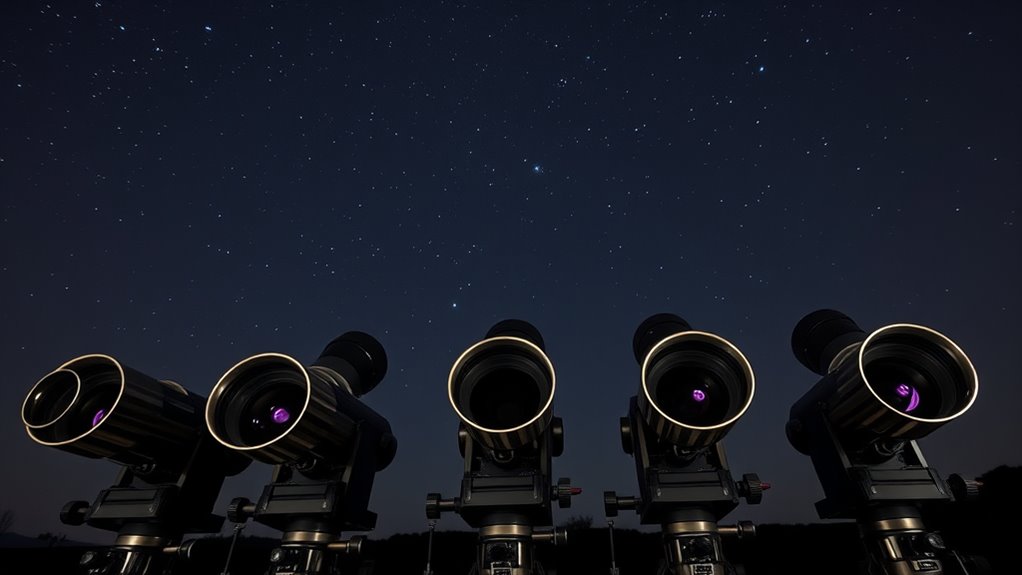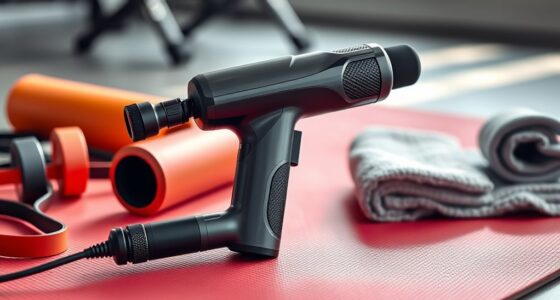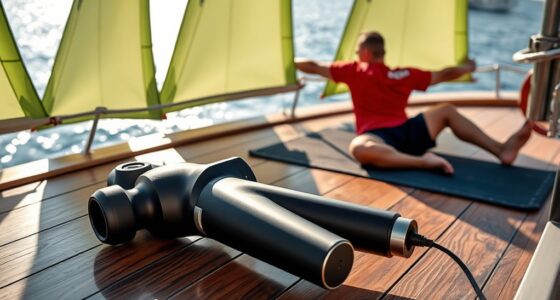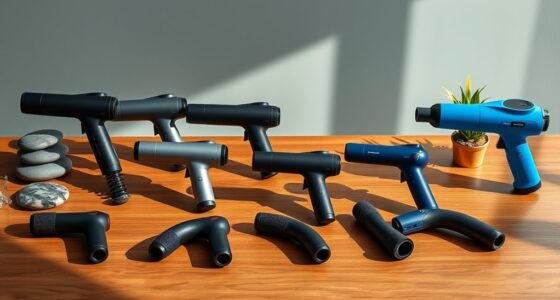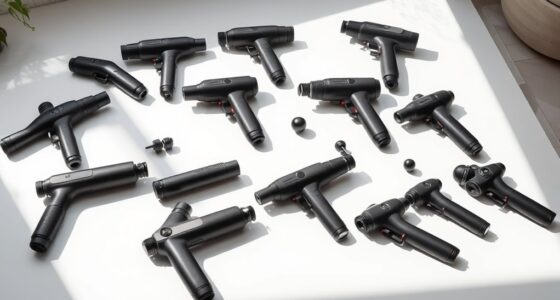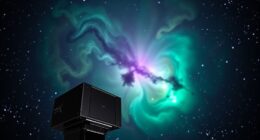If you’re looking for the best 130mm triplet APO refractors for astrophotography in 2025, I recommend exploring options like the Explore Scientific FCD100 Series ED102 and the FCD100 Series 127mm f/7.5. These models combine exceptional optical quality with portability and strong mounting compatibility. They deliver sharp, high-contrast images perfect for both planetary and deep-sky captures. Stay with me to discover more about their features and how to choose the best one for your needs.
Key Takeaways
- Look for models with genuine FCD100 or FCD1 ED glass for superior image clarity and minimal chromatic aberration.
- Prioritize focal lengths around 714mm to 952mm for detailed planetary and deep-sky astrophotography.
- Ensure compatibility with stable, motorized mounts supporting the refractor’s weight for precise tracking.
- Consider portability features like lightweight construction and retractable dew shields for field use.
- Balance price and features, focusing on multi-layer coatings, quality focuser, and optical performance for best value.
Explore Scientific FCD100 Series 80mm Refractor Telescope
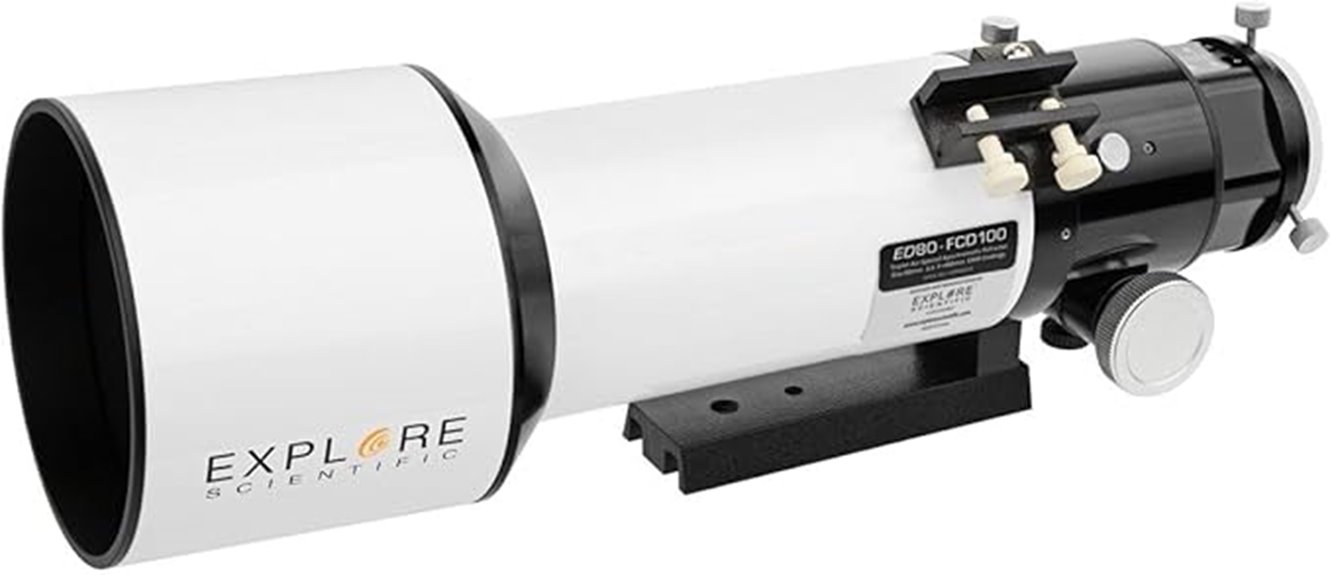
If you’re serious about astrophotography and need a portable, high-quality refractor, the Explore Scientific FCD100 Series 80mm Triplet APO Refractor is an excellent choice. Its air-spaced triplet design with genuine Hoya FCD100 ED glass virtually eliminates chromatic aberration, giving you sharp, high-contrast images of the Moon, planets, and deep-sky objects. With a 480mm focal length and f/6 ratio, it offers versatile imaging capabilities. The 2.5-inch focuser with a 10:1 ratio ensures precise focus, while the lightweight, compact build makes it perfect for field use. Overall, it’s a reliable, portable option for both astrophotography and visual observing.
Best For: amateur astronomers and astrophotographers seeking a portable, high-quality refractor for detailed lunar, planetary, and deep-sky imaging.
Pros:
- Virtually eliminates chromatic aberration thanks to genuine Hoya FCD100 ED glass and air-spaced triplet design
- Precise 2.5-inch focus with 10:1 dual-speed rack-and-pinion for accurate focusing
- Lightweight and compact, making it ideal for field use and spontaneous stargazing
Cons:
- May require additional accessories (like mounts and adapters) for optimal setup and use
- Premium optical glass and features can lead to a higher price point compared to entry-level telescopes
- Not suitable for very large astrophotography setups or deep-sky imaging with heavy equipment
Explore Scientific ED102 Refractor Telescope for Astrophotography

The Explore Scientific ED102 Refractor Telescope stands out as an excellent choice for amateur astronomers and astrophotographers seeking high-quality images without sacrificing portability. Its genuine FCD1 HOYA ED glass and multi-layer coatings deliver sharp, high-contrast views, perfect for capturing planets, nebulae, and star clusters. The air-spaced triplet design effectively eliminates chromatic aberrations, guaranteeing crisp images. With a 102mm aperture and f/7 focal ratio, it offers great versatility for astrophotography. Its compact, lightweight build, combined with a retractable dew shield and sturdy handle, makes setup easy. Plus, reliable local support assures peace of mind for both beginners and seasoned users.
Best For: amateur astronomers and astrophotographers seeking a portable, high-quality refractor for capturing planets, nebulae, and star clusters.
Pros:
- High-contrast, detailed views thanks to genuine FCD1 HOYA ED glass and multi-layer coatings
- Effective elimination of chromatic aberrations with air-spaced triplet design, ideal for astrophotography
- Compact and lightweight with features like a retractable dew shield and sturdy handle for easy setup and transport
Cons:
- Slightly higher cost compared to entry-level refractors with similar apertures
- Limited aperture size may restrict deep-sky imaging of faint objects
- Requires precise collimation adjustments for optimal performance, which may be challenging for beginners
Explore Scientific FCD100 Series ED102 Refractor Telescope (OTA Only)

Designed for dedicated astrophotographers seeking exceptional image quality, the Explore Scientific FCD100 Series ED102 refractor stands out with its premium optics and precise construction. It features genuine HOYA FCD100 extra-low dispersion glass, delivering sharp, high-contrast images. The proprietary EMD multi-layer coatings optimize light transmission and reduce reflections, ensuring excellent clarity. With a 102mm aperture, 714mm focal length, and 1.14 arcsecond resolution, it’s perfect for detailed astrophotography. Its durable, air-spaced aluminum tube provides stability while remaining lightweight at just under 11 pounds. This OTA-only package offers a versatile, high-performance platform for astrophotographers demanding quality and portability.
Best For: dedicated astrophotographers seeking high-quality, portable apochromatic refractors for detailed astronomical imaging.
Pros:
- Features genuine HOYA FCD100 ED glass for exceptional image clarity and high contrast.
- Proprietary EMD multi-layer coatings maximize light transmission and reduce reflections.
- Lightweight and durable air-spaced aluminum construction offers stability and portability.
Cons:
- OTA-only package requires additional mounts or accessories for full telescope setup.
- Slightly higher cost due to premium optics and coatings.
- Limited aperture size may not be suitable for deep-sky objects requiring larger telescopes.
Explore Scientific FCD100 Series 127mm f/7.5 Carbon Fiber Triplet ED APO Refractor Telescope

For astrophotographers seeking a lightweight yet high-performance refractor, the Explore Scientific FCD100 Series 127mm f/7.5 Carbon Fiber Triplet ED APO stands out. With a 127mm aperture, 952mm focal length, and f/7.5 ratio, it offers sharp, detailed images with minimal chromatic aberration thanks to its ED triplet design. Weighing only 14 pounds and featuring a 2.5″ HEX focuser, it’s both portable and precise. Capable of capturing faint objects up to magnitude 13 and resolving details at 0.9 arcseconds, it’s an excellent choice for serious astrophotographers who need quality without bulk.
Best For: serious astrophotographers and astronomers seeking a lightweight, high-quality refractor with exceptional optical performance for detailed celestial imaging.
Pros:
- ED triplet design minimizes chromatic aberration, providing sharp, color-accurate images.
- Lightweight at only 14 pounds, making it portable and easy to transport.
- Capable of resolving fine details at 0.9 arcseconds and capturing objects up to magnitude 13.
Cons:
- Customer reviews average only 2.3 out of 5 stars, indicating potential issues or dissatisfaction.
- Higher price point may be a barrier for budget-conscious users.
- Limited availability or stock fluctuations could affect immediate purchase options.
Celestron StarSense Explorer DX 130AZ Telescope with Smartphone Dock
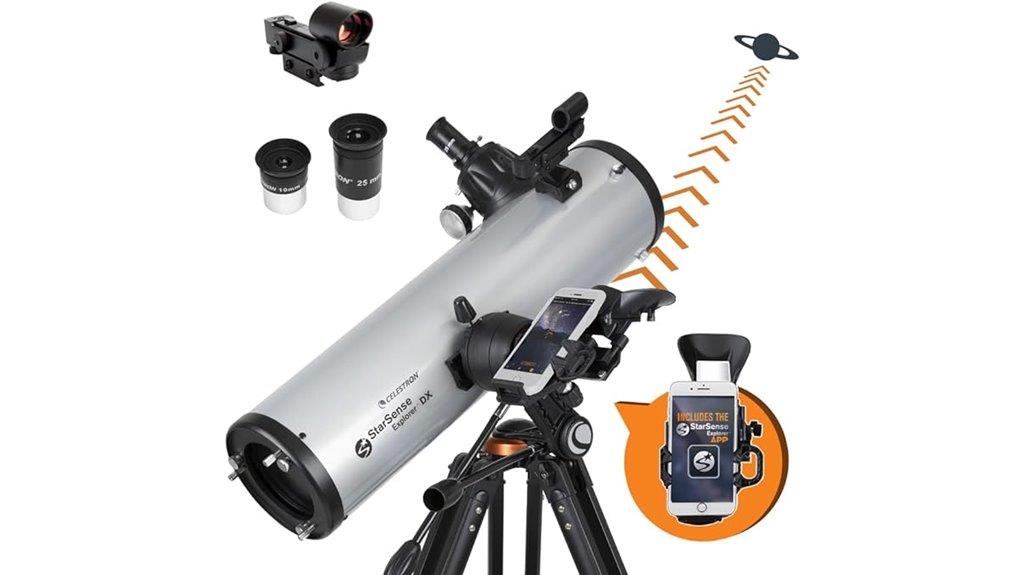
If you’re new to astrophotography and want an easy-to-use telescope that combines smart technology with solid optical performance, the Celestron StarSense Explorer DX 130AZ is an excellent choice. It features a 130mm Newtonian reflector with high-reflectivity coatings, providing bright views of the Moon, planets, and deep-sky objects. The app-enabled design uses patented sky recognition technology and LISA to help you locate objects effortlessly. With a simple setup, manual altazimuth mount, and smartphone dock, it’s perfect for beginners seeking an engaging, guided stargazing experience. Weighing 18 pounds and supported by Celestron’s reliable warranty, it’s a smart entry point into astrophotography.
Best For: beginners and amateur astronomers seeking an easy-to-use, app-guided telescope for exploring the Moon, planets, and deep-sky objects.
Pros:
- User-friendly smartphone app with sky recognition technology simplifies object locating
- Solid optical performance with a 130mm Newtonian reflector provides bright, detailed views
- Includes essential accessories such as two eyepieces, full-height tripod, and smartphone dock for versatile stargazing
Cons:
- Manual altazimuth mount requires some adjustment for tracking objects over time
- Heavier weight (18 pounds) may be less portable for travel or outdoor setups
- Limited to basic astrophotography capabilities, not suitable for advanced astrophotography needs
Factors to Consider When Choosing 130MM Triplet APO Refractors for Astrophotography
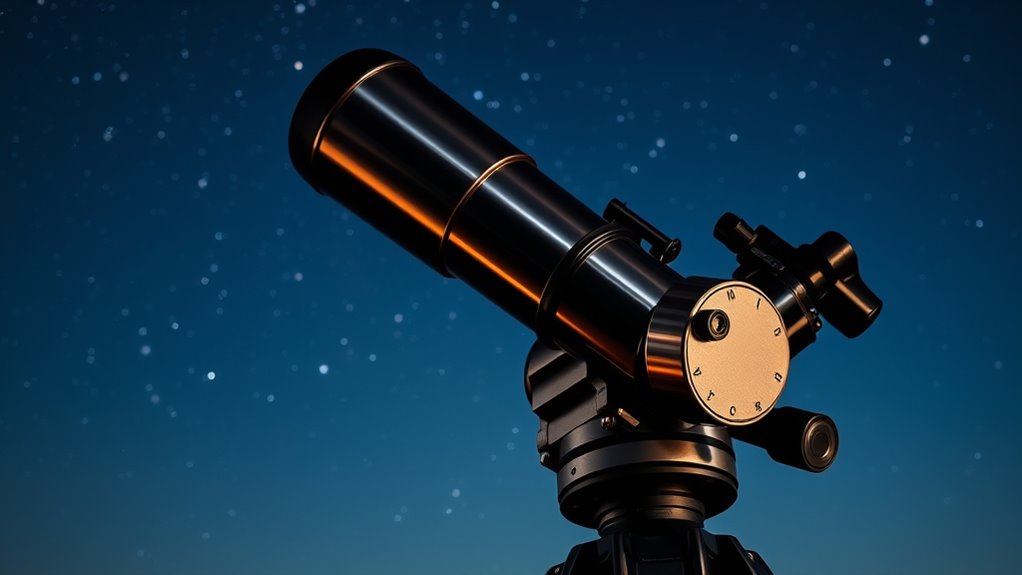
When selecting a 130mm triplet APO refractor for astrophotography, I focus on key factors like optical quality, focal length, and mount compatibility to guarantee clear images and steady tracking. I also consider portability and price to find a setup that fits my needs and budget. Understanding these points helps me make an informed choice that balances performance and value.
Optical Quality and Glass
Optical quality and glass selection are vital factors that determine a 130mm triplet APO refractor’s performance in astrophotography. Using genuine FCD100 and FCD1 extra-low dispersion (ED) glass ensures superior image clarity, high resolution, and minimal false color. These materials help produce sharp, detailed images of planets and deep-sky objects. Multi-layer coatings on all optical surfaces further enhance light transmission, boost contrast, and reduce reflections, resulting in more vibrant, contrast-rich images. The air-spaced triplet design effectively minimizes chromatic aberration across the visible spectrum, providing sharper, color-accurate results. Overall, the quality of the glass and coatings directly impacts the telescope’s ability to deliver high-contrast, true-to-life astrophotos, making them essential considerations when choosing a top-tier astrophotography refractor.
Focal Length and Speed
Focal length and focal ratio considerably influence how a 130mm triplet APO refractor performs in astrophotography. Longer focal lengths, like 714mm or 952mm, deliver higher magnification and detailed planetary images, ideal for close-up shots. Conversely, shorter focal lengths provide a wider field of view, better suited for deep-sky objects. Faster focal ratios, such as f/6 or f/7.5, enable shorter exposure times and improve imaging of faint objects by gathering more light quickly. A lower f/ratio increases light collection, making it easier to capture dim celestial bodies. Balancing focal length and speed is essential to optimize image resolution, reduce aberrations, and meet specific astrophotography goals. Selecting the right combination depends on whether you prioritize planetary detail or deep-sky imaging.
Mount Compatibility and Stability
Choosing the right mount is crucial because even the best 130mm triplet APO refractor won’t perform well if it’s not properly supported. First, verify your mount or tripod is compatible, whether it’s Vixen-style or Losmandy dovetails. The mount must support the telescope’s weight, typically between 8 and 15 pounds, to avoid strain and vibrations. Precise tracking is critical for astrophotography, so look for mounts with motor drives and accurate tracking capabilities. Smooth, backlash-free movement helps prevent star trail streaks and ensures accurate target positioning. Stability matters too—robust, vibration-free tripods and legs are essential for capturing sharp, long-exposure images. A well-matched, stable mount greatly enhances your astrophotography results.
Portability and Weight
Since portability can make or break your astrophotography experience, it’s vital to take into account how much a 130mm triplet APO refractor weighs before making a purchase. These telescopes typically weigh between 10 and 20 pounds, impacting how easily you can transport and set them up in the field. Lighter models, often crafted with carbon fiber or aluminum tubes, are ideal for travel and quick setups. Heavier units require sturdy mounts and tripods to guarantee stability during imaging sessions. Compact designs with foldable or retractable components also enhance portability, making it easier to carry equipment over long distances or tight spots. Balancing weight and aperture size is essential, especially if you plan to hike or have limited transport options.
Price and Value
When evaluating different 130mm triplet APO refractors, the price you pay often reflects their optical quality and build. Higher-quality models usually come with advanced optical materials like ED glass, multi-layer coatings, and precision craftsmanship, which drive up costs. The best value isn’t necessarily the cheapest; it’s about balancing optical performance, build quality, and included accessories. Investing in a reputable brand with good customer support often offers better long-term value through durability and service. Be cautious of extremely low-priced options, as they may sacrifice optical quality or lack essential features for astrophotography. Comparing features such as focuser quality and coatings helps ensure the price aligns with the telescope’s capabilities, giving you the best return on your investment.
Frequently Asked Questions
How Do 130MM Triplet APOS Compare in Image Quality With Larger Aperture Telescopes?
In my experience, 130mm triplet APO refractors deliver excellent image quality, especially for their size. They provide sharp, high-contrast views and minimal chromatic aberration. While larger aperture telescopes gather more light and reveal fainter details, these triplets excel in portability and optical precision, making them ideal for detailed astrophotography. For most amateur astronomers, they strike a perfect balance between performance and practicality.
What Accessories Are Essential for Optimal Astrophotography With These Refractors?
Ever wondered what gear elevates your astrophotography? Essential accessories include a sturdy mount for steady tracking, a quality camera adapter, and a reliable guide scope for precise alignment. I also recommend a dew shield to prevent moisture buildup and filters to enhance image contrast. Do you have these essentials? They make a significant difference in capturing sharp, vibrant images with your 130mm triplet APO refractor.
Are These Telescopes Suitable for Beginner Astrophotographers?
Absolutely, these telescopes are great for beginners. I found that their high-quality optics make learning astronomy more enjoyable and less frustrating. They’re relatively easy to set up and provide sharp images, helping new astrophotographers build confidence. Plus, their versatility allows for both deep-sky and planetary viewing. If you’re just starting out, I’d recommend a 130mm triplet APO for a smooth, rewarding introduction to astrophotography.
How Does Chromatic Aberration Affect Images in These Models?
Chromatic aberration can cause colorful fringes around stars and deep-sky objects, which diminishes image clarity. In these models, the APO design minimizes this issue markedly, resulting in sharper, more accurate images. I’ve noticed that high-quality glass and precise lens alignment further reduce color fringing. Overall, these refractors deliver clean, detailed visuals ideal for astrophotography, especially when compared to less advanced telescopes that struggle with chromatic aberration.
What Maintenance Concerns Should I Consider for Long-Term Use?
Thinking long-term, I keep my refractor in good shape by regularly checking for dust and moisture, which can be subtle enemies. I gently clean the lenses with proper tools, avoid harsh chemicals, and store it in a cool, dry place. Ensuring the mount and focuser stay smooth prevents unnecessary wear. Consistent care helps maintain pristine images and extends the life of my investment.
Conclusion
Choosing the right 130mm triplet APO refractor can feel like finding a needle in a haystack, but with the right info, it’s a walk in the park. Whether you’re after crisp astrophotos or reliable performance, these top picks will serve you well. Remember, it’s all about matching your needs with the right gear. So don’t put all your eggs in one basket—trust your instincts, and you’ll be shooting stunning images in no time.
